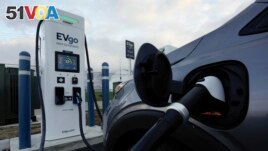12 April 2023
The administration of U.S. President Joe Biden is aiming for new rules to push electric vehicle sales in the United States.
Biden wants the Environmental Protection Agency, or EPA, to place new restrictions on pollution coming from cars and trucks.
The effect of the rules is that most new vehicles sold in the U.S. will need to be electric by 2032.

FILE - An electric vehicle charges at an EVgo fast charging station in Detroit on Nov. 16, 2022. (AP Photo/Paul Sancya, File)
The new rules limit pollution that can come from cars and trucks produced between 2027 and 2032. The proposal is stronger than the one automakers agreed to less than two years ago.
The plan could be put in place by 2024. It is part of Biden's stated goal to cut in half greenhouse gasses from the U.S. by 2030. Scientists say greenhouse gasses trap heat in the Earth's atmosphere.
Here are details about the EPA's proposal.
The proposal
The EPA will not tell automakers how many electric vehicles they must sell each year. Instead, the government's pollution restrictions will influence the kinds of cars and trucks automakers can offer. The EPA believes most smaller vehicles sold by 2032 will be electric and just under 50 percent of larger vehicles, such as trucks, will be electric.
The head of the EPA is Michael Regan. Biden appointed him to lead the agency in 2021. Regan said the plan is "the most ambitious...ever for cars and trucks." He said it would result in cleaner air and lower fuel costs for Americans.
What do automakers say about the plan?
John Bozzella is the leader of an automotive trade group called the Alliance for Automotive Innovation. He called the new plan "aggressive" and expressed concern that the goals are too high.
He said the Biden administration announced a policy less than two years ago that was already difficult for automakers to put in place. That policy required 50 percent of all new vehicles to be electric by 2030. Bozzella called that plan a "stretch goal."
He said the success of either plan still depends on two important factors: First, automakers must be able to produce enough electric vehicles to reach the goals. Second, most Americans need to be able to pay for the new cars.
Bozzella said the question is not whether this can be done; "It's how fast can it be done?" He said the new plan requires "the right policies and market conditions."
How will the proposal help the environment?
The EPA says the new requirements would reduce pollution from vehicles by 56 percent compared to the rules set for vehicles made in 2026. They would improve air quality and save car owners thousands of dollars in fuel costs. In addition, the U.S. would not need to import as much oil.
Is the plan realistic?
In the first three months of 2023, electric vehicles accounted for 7.2 percent of all vehicles sold in the U.S. Electric vehicle sales appear to be increasing. Last year, 5.8 percent of all new vehicles sold were electric.
Automotive industry experts and research organizations say the cost of electric vehicles and the difficulty of charging them will continue to be a problem for Americans.
LMC Automotive is an industry research company. It said new electric vehicle sales could make up 49 percent of all sales by 2032. But the number may not go above that until costs come down.
A recent public opinion study said most Americans do not want to buy electric cars. Only 19 percent of those who took part said the next time they buy a car; it will be electric. Just under half said they were unlikely to buy an electric car.
One member of the Biden administration, however, said the goals are reachable with the "lead time" they have. Ali Zaidi is Biden's climate adviser. He said the number of electric cars available has doubled and sales have tripled since Biden took office.
"The automakers have...technology and infrastructure and supply chain to be able to achieve this," Zaidi said.
Why is the new plan important?
Transportation is said to be the largest producer of carbon gasses in the U.S. The EPA said transportation uses produced about 27 percent of gasses released in 2020. Electric power production came second with 25 percent of gases produced.
Environmental groups say reducing pollution from cars and trucks would clean the air. They say less carbon gasses will reduce problems from bad weather such as hurricanes, tornadoes and fires.
What else is Biden's government doing to help?
The Biden administration is offering some Americans help in purchasing electric vehicles in the form of a tax credit. However, the reduced taxes are only available to Americans with incomes below a certain level. In addition, not all cars and trucks qualify for the full tax credit.
Kelley Blue Book is a company that reports on the price of new and used vehicles. It said the smaller credit might not be enough to persuade Americans to buy electric cars. Right now, the average cost of an electric vehicle is about $58,000.
I'm Dan Friedell.
Dan Friedell adapted this story for Learning English based on a report by the Associated Press.
___________________________________________________________________
Words in This Story
ambitious–adj. requiring great effort or desire to do something
factor –n. a condition needed to get something done
charge –v. to add electricity to a device that provides a machine with power, usually to run a motor
infrastructure –n. the things needed in a modern society such as roads, bridges, power centers, railways and ports
supply chain –n. a network of businesses that supply the materials and parts needed to provide people with products and goods
achieve –v. to reach a goal
income –n. money made from work or investment